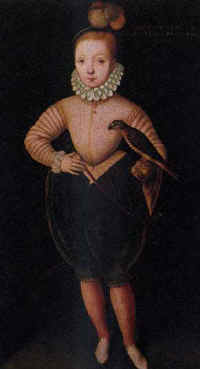 James aged 8 |
Mary gave birth to James on 19 June 1566 at Edinburgh Castle. It was a difficult birth and the child that was born was frail. Rumour soon spread which would haunt James for the rest of his life. The first of these rumours was that James was not Lord Darnley's child but Bothwell's. This can be dismissed by the fact that at the time of his conception, Mary was still infatuated with Darnley, and by the child's resemblance to his father. Secondly, there is a theory that James actually died at birth and was replaced by one of Erskine, Lord of Mar's child. This is substantiated by the remains of a baby skeleton found within the walls of Edinburgh Castle in the 18th century. This again is highly unlikely. On 17 December 1566 James was christened at Stirling Castle according to Catholic rites. Darnley was as per usual absent, and so was the godmother, Queen Elizabeth I who merely sent a gold font and a representative who remained outside in protest of the Catholic ceremony. While incarcerated at Lochleven Mary, under duress, signed her abdication in favour of her son. James aged only 13 months, was crowned on 29 July 1567 in a Protestant church outside Stirling Castle. Mary's half-brother, the Earl of Moray, finally reached his goal by becoming Regent. By May 1568 Mary had escaped from Lochleven and retreated to England after the Battle of Langside. Moray was assassinated in 1570 and the Earl of Lennox, Darnley's father, took over as Regent. He died in a foray in 1571 before James's very eyes. He was succeeded by the Earl of Mar and then by the Earl of Morton in 1573. James was brought up under the strict Presbyterianism of his senior tutor, George Buchanan, staunch enemy of Mary, in the stern atmosphere of the Mars, his guardians. The result was a highly intellectual and well-educated young man with a wry sense of humour but with a craving for love which was to be his downfall. He inherited some of his mother's traits. James did not inherit his parent's good looks. He was of middle height but he was born with bent legs which impaired his walking throughout his life. Nevertheless, James developed the same love of horse-riding and the outdoors as his mother had.Like her he enjoyed a glamorous court life, surrounding himself with poets and musicians. He was also very fond of pun games, a tendency which Mary displayed herself in her embroideries. James was characterised by a mixture of self-confidence and self-indulgence. He was a misogynist but needed to produce heirs. He married Anne of Denmark and had seven children although only two survived. His marriage was described as being as happy as a royal marriage could be. It is safe to assume that marital relations continued for at least sixteen years despite James's obvious sexual preferences. Aged 13, James had experienced his first romantic feelings with a French connection of the Stuarts, Esme Stuart Sieur d'Aubigny. The latterquickly rising to Duke of Lennox and having the Earl of Morton arrested and executed in 1581 for his role in the murder of Lord Darnley. On 22 August 1582, the Earl of Gowrie kidnapped James and forced him to issue a proclamation against Esme. James was devastated. He later became infatuated with Robert Carr, a very good-looking young man of Scottish descent and twenty years his junior. They met at a tournament during which Carr broke his leg. James attracted attention to them by fussing over him and kissing him in public. Thanks to James's devotion Carr became the first Scot to enter the House of Lords and considerably wealthy. His most outstanding quality however was insolence. Then followed George Villiers, James's greatest love, whom he liked to call his "sweet child and wife". George too was handsome but arrogant and corrupt. And so, just as his mother's love life had scandalised her contemporaries, so did his. James asked no questions about his mother. He would never see her again after her quick visit in April 1567 and George Buchanan instilled in his mind the portrait of an adulteress and a murderess. He received few of the gifts that she sent him from her prisons in England and was deprived of any maternal love. Against this background, his indifference towards his mother finds an explanation. Fontenay, Mary's emissary, reported rightly or not, that James did love his mother. There are also conflicting stories about James's feelings towards Mary. Upon her death some report that he said "Now I am sole King", and some that he retired without eating, others still that he remained totally impassive. James's conscience seems to have nagged him about the subject of his mother later on in life. He derided George Buchanan's lies about Mary in his book "Detection", he instructed Camden to give her due honour for her sufferings, and castigated Moray in his "Basilikon Doron". In 1612 he had Mary's body transferred to Westminster Abbey on the suggestion of Northampton, a secret catholic. It nevertheless remains that James conveniently rejected his mother's appeals to rule jointly and form an Association, giving preference to an alliance with Elizabeth. It is hard not to see in that a rather self-centred and opportunist character. The Juggle and Rule Principle Being born in Scotland and spending the first 36 years of his life there gave James an advantage which his mother had been lacking. Mary had been baffled by the deviousness of her times and the warring factions of the Scottish nobility. James, on the other hand would master the art of keeping his options open at all levels. James had inherited a poor country divided by religious factions and Stewart rivalry with the Crown. Parliament, known as the Estates, consisted of a single and weak chamber. James's main claim was that the Sovereign's right was derived straight from God. He favoured the Episcopalian Church with bishops and the King at its Head. Presbyterians however claimed that the ecclesiastical power was above the Crown. Nevertheless, both sides co-existed in relative harmony during his reign. His juggle and rule principle involved enlisting the help of Catholics such as Huntly and Lord Maxwell to protect himself against the Presbyterians, but secretly so as not to offend the Protestant Elizabeth and her valuable financial resources. On the other hand, he would restore Presbyterianism to sweet-talk its ministers into counteracting the power of the Catholics. The lawlessness of the Scottish aristocracy was a little more difficult to deal with. James felt that it was time for a middle party: "Between foolish rashness and extreme length, there is a middle way". He thus proceeded to turn his attention to the middle classes while placating co-operative Lords with lands and forcing uncooperative ones out of the country. There followed a period of economic growth and political stability long overdue which lasted for forty years. Unfortunately, this prosperity did not stretch to the King's own finances. James by then, had his eyes seriously set on the English Crown. James's claims to the English Throne It is true that James's existence in itself was the fruit of Mary's efforts to produce an heir who would acquire the English Crown which she herself could have had claim to. However, James's greed in this respect shows a rather sinister side of him. The argument finds its source in Henry VIII's will. According to this will, no alien was to succeed to the Crown of England. James, being three-quarters Scottish and one-quarter French was therefore excluded. His father's brother had had a daughter, Arbella Stuart who was English and was a very strong contestant to the Crown. She was English but had weak protestant views. As a child, she had kept Mary company during her incarceration in England and Mary had been so fond of her as to make provisions for her in her will. James first made sure that she did not marry and when she finally eloped with William Seymour, grandson of Lady Catherine Grey, he had her imprisoned in the Tower where she died in 1615. It has been suggested that James's ascension to the English throne had been plotted for a long time by Cecil, Elizabeth's secretary, through secret correspondence with James. Whatever the case may be, Elizabeth died peacefully on 24 March 1603 and James was naturally proclaimed King. The court of King James was a stark contrast to the court of Queen Elizabeth. James was neither used to nor enjoyed ceremony. His response to his people's welcome was "God's wounds, I will pull down my breeches and they shall also see my arse". Drunkenness was rife and in 1606, when the King of Denmark came to visit, it spread to the ladies while the performers staggered in corners unable to finish their performance. Further, James had no experience of the English Parliament. The latter was responsible for legal grants, direct taxation and the Crown was badly indebted. Coupled with James's generosity towards all of those whose love he attempted to buy, it was a recipe for disaster. James would dissolve Parliaments upon Parliaments forever disputing the meaning of royal prerogative and in vain trying to obtain more funds for his ventures. James also clashed with the Puritans whom he associated with the Scottish Presbyterians and who became the party of dissent. At the same time, he failed to relax laws against Catholics and conjured up Spain's displeasure. By the Great Contract he struck a deal with Parliament in order to curb his debts but the English began to romanticise Elizabeth and her reign. In 1605, Guy Fawkes and others tried to blow up the monarch by placing gunpowder in a room next to the House of Lords the day before James was due to open Parliament. This plot was betrayed by an anonymous letter and continues to be celebrated every year on 5 November. It has been suggested that Cecil was behind this or that the government knew about it but was waiting for the most appropriate moment to uncover it, i.e. the opening of Parliament. James remained in constant fear for his life. James, The Visionary In many ways, James was ahead of his times. His love of wildlife and in particular his obsession with lions prompted him to import exotic animals into Britain which were kept in the Tower of London. He introduced horse-racing and bred horses with the finest Arab blood. One of James's pet hates was smoking which he desecrated in his book "Counterblaste to Tobacco". In 1600 he insisted on starting the Scottish New Year on 1st January like the rest of Europe, while England continued to celebrate it on 25th March for another century and a half. He translated the Bible which became the Authorised Version of the Bible. But behind this religious lay a fanatical hatred and pathological fear of witchcraft, epitomised in his other book "Demonology" (external site). The most notorious witch trial in Scotland, The Trial of the Berwick Witches, revolved around a group of people who were accused of stirring up a storm in an attempt to drown James and his new wife on their voyage back from Denmark. He made proposals for unity in Great Britain and economic integration which did come to be realised although not in his lifetime. James was responsible for the building of magnificent halls in England such as Hatfield Hall. Shakespeare's plays, some of which were based on him such as MacBeth, were avidly attended by James. He visited Oxford University where he got drunk with undergraduates, and Cambridge University where the reception was cooler. He granted the founding Charter of Edinburgh University in 1582 and considered himself its godfather. James also started the British Empire by his plantations in Massachusetts, Bermuda, Newfoundland, Guyana, India and the East Indies. He founded the Virginia Company, a plantation of mulberry trees destined to feed silk worms. The worms however never reached Virginia. Demise "Look not for the softness of a down pillow in a crown, but remember that it is a thorny piece of stuff and full of continual cares." The Thirty Years War hit Europe when James was aged 54 and in bad health. James, like his mother before him, suffered from the Stuart disease porphyria. This unpleasant illness which manifested itself by abdominal and rheumatic pain and mental disturbance did not prevent him from being reunited with his native country Scotland in 1617. He depuritanised the Scottish church and by his "Book of Sports" made it permissible to dance, play and drink church ales. That same year a Sir Walter Raleigh was let out of prison to search for gold up the Orinoco. The expedition ended in disaster when he clashed with the Spaniards and had to be executed. James was branded a puppet in the hands of the Spanish Ambassador Gondomar. James's pro-catholic policies and Spanish alliance combined with protestant negotiations were severely criticised in England. His belief in peaceful government was classified as leniency or fear and the East India company brought out James's worst faults: laziness in conducting business, favouritism and incompetence with money. His son Prince Charles formed a coalition with another of James's handsome young favourites, the Duke of Buckingham, to challenge his father's policies. By 1620 the Great Depression had brought economic collapse and the decline of trade to England. In 1623 James reluctantly consented to Charles and Buckingham to go to Spain to woo the infanta Anna Maria. However the whole expedition failed miserably. In 1625 James collapsed with porphyria or a stroke which left him speechless. Buckingham was later accused of having poisoned him by treating him with "homeopathic" remedies. He died on 27 March 1625 aged 59. His autopsy revealed sound vitals and a head "full of brains" but his blood was described as wonderfully tainted with melancholy. His funeral was held at Westminster Abbey, the most glamorous and expensive of its time and later a model for Cromwell's funeral in 1658. The position of his body remained unrecorded until, 250 years later, Dean Stanley instituted a search. James's body was found in the tomb of Henry VII, the first Tudor monarch. |
 The Earl of Mar |
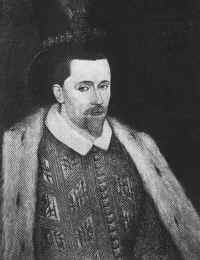 James aged 27 |
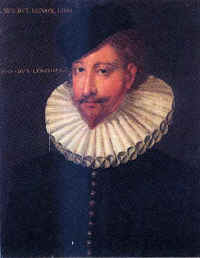 Esme Stuart |
|
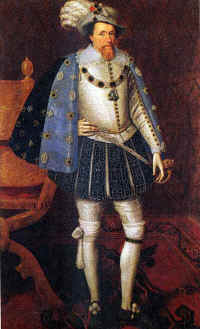 James in his 30s |
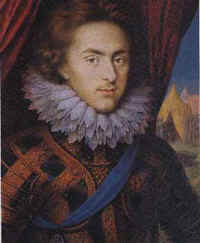 Prince Henry |
|
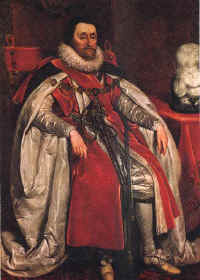 James older |
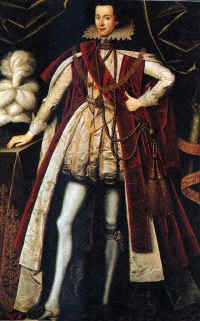 The Duke of Buckingham |
|